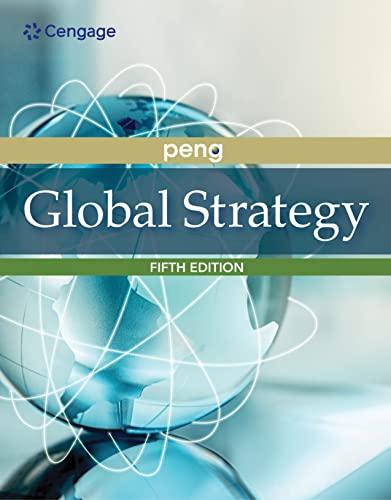If you are a college student in the United States or Canada, you may have heard of
Question:
If you are a college student in the United States or Canada, you may have heard of (or taken a ride on) Megabus. Its website announces that it is “the first, low-cost, express bus service to offer city-to-city travel for as low as $1 via the Internet.” Currently serving hundreds of North American cities from 12 hubs (Atlanta; Chicago; Dallas; Fort Lauderdale;
Janesville, Wisconsin; Los Angeles; Miami; New York; Orlando; Philadelphia; Toronto; and Washington, DC), Megabus, according to Bloomberg Businessweek, “has fundamentally changed the way Americans—especially the young—travel.”
A generation ago, Greyhound was a national icon for intercity bus travel. Unfortunately, as Americans and Canadians fell more in love with cars and the cost of airfares dropped further, intercity bus ridership steadily decreased. Further, as inner cities, where the bus depots (terminals) were situated, decayed, bus travel had become the travel mode of last resort. In 1990, Greyhound filed for Chapter 11 bankruptcy.
Yet, the demand for medium-distance trips that are ideal for intercity bus does not go away. For some of the most traveled routes (such as between Chicago and Detroit and between New York and Washington, DC), the distance is too far for a leisurely drive but too close to justify the expense (and increasingly the hassle) of air travel. While Greyhound has been in decline, small, entrepreneurial bus operators known as the Chinatown buses emerged. They started by shuttling passengers (primarily recent Chinese immigrants) between Chinatowns in New York and Boston.
Such niche operators quickly grabbed the attention of many college students. Despite four decades of decline, overall US intercity bus ridership spiked in 2006, the year during which Megabus entered the US market. In 2008, Megabus entered Canada.
Although Megabus is a brand new, no-frills entrant into the North America market, it is backed by the full strengths of the second-largest transport firm in Britain, Stagecoach Group, which employs 18,000 people there. Founded in 1980 and headquartered in Perth, Scotland, Stagecoach not only operates buses, but also trains, trams, and ferries throughout Britain, moving 2.5 million people every day. It is listed on the London Stock Exchange, where it is a member of the FTSE 250. Megabus is a brand of Stagecoach’s wholly owned US subsidiary, Coach USA.
Stagecoach is not a stranger to international forays, having previously operated in Hong Kong, Kenya, Malawi, New Zealand, Portugal, and Sweden. However, these operations turned out to be lackluster and were all sold. For now, the sole international market it focuses on is North America.
Although Megabus is clearly a late mover in North America, its future looks bright. So what allows Megabus to turn a declining national trend of bus ridership around?
At least four features stand out. First, tickets are supercheap, starting at $1 (!). Megabus uses a yield management system, typically used by airlines, which offers early passengers dirt-cheap deals and late passengers progressively higher prices. Although only one or two passengers per trip can get the $1 deal, even the “higher” prices are very competitive. In routes where it competes with Amtrak (the railway), Megabus costs about a tenth of Amtrak. All tickets have to be booked online. This not only eliminates the expenses of maintaining ticket booths, but also attracts a more educated demographic group.
Second, instead of using depots, Megabus follows the Chinatown buses by using curbside stops (like regular city bus stops) to board and disembark passengers. Interestingly, dumping the depot model not only saves a lot of money, but also makes Megabus more attractive because passengers do not have to spend time in the typically poorly maintained (and sometimes filthy and unsafe) bus depots.
Third, all Megabus coaches are equipped with Wi-Fi and power outlets, allowing the time on board to be more productive (or more fun). These features have made travel by bus totally cool to the online savvy, younger crowd.
Among surveyed passengers, 37% said that Wi-Fi and power outlets were central to their decision to travel by Megabus.
Finally, as gas prices and environmental consciousness rise, bus travel offers an unbeatable “green” advantage. At eight cents per mile, a bus is four times more fuel-efficient than a car. US curbside carriers, led by Megabus, have already reduced fuel consumption by 11 million gallons a year, equivalent to taking 24,000 cars off the road. While politicians like to talk about the “bright future” of highspeed rail and $10 billion has been budgeted to jump-start the new rail projects, not a single high-speed railway has been in service as of this writing. At the same time, Megabus has been charging ahead and carrying more than 13 million passengers since its entry, while requiring zero additional investment in infrastructure. Given the cost and political headache to build new high-speed rail, Bloomberg Businessweek speculated: “The Megabus approach works so well, it may scuttle plans for high-speed rail.”
Case Discussion Questions
1. Facing an iconic local incumbent, how does Megabus overcome its liability of foreignness?
2. Why is Megabus able to transform a lackluster travel mode to one that attracts a younger and more educated crowd?
3. If you were CEO of the “new (post-Chapter 11 bankruptcy) Greyhound,” how would you react to the competitive challenges brought by Megabus?
Step by Step Answer:






